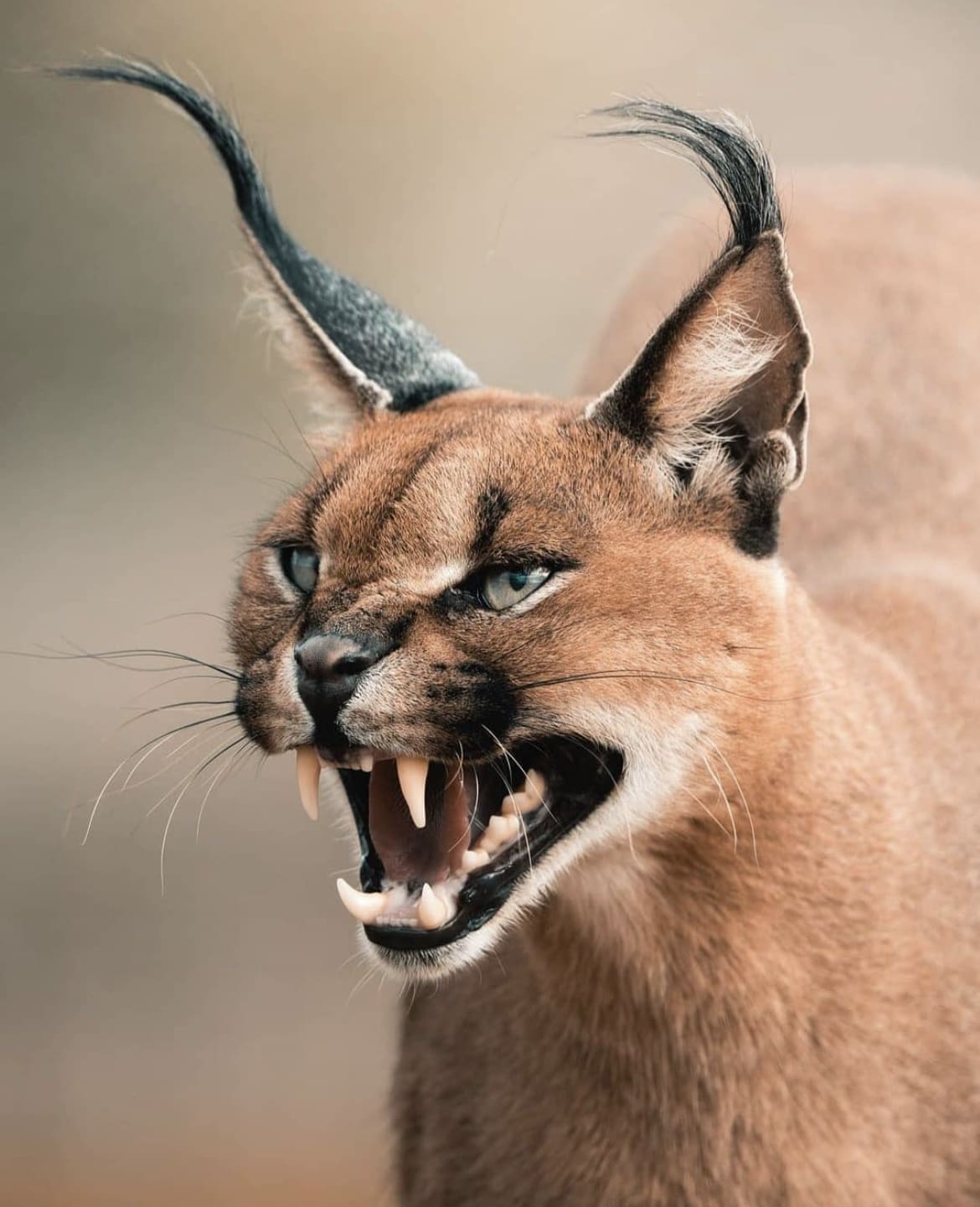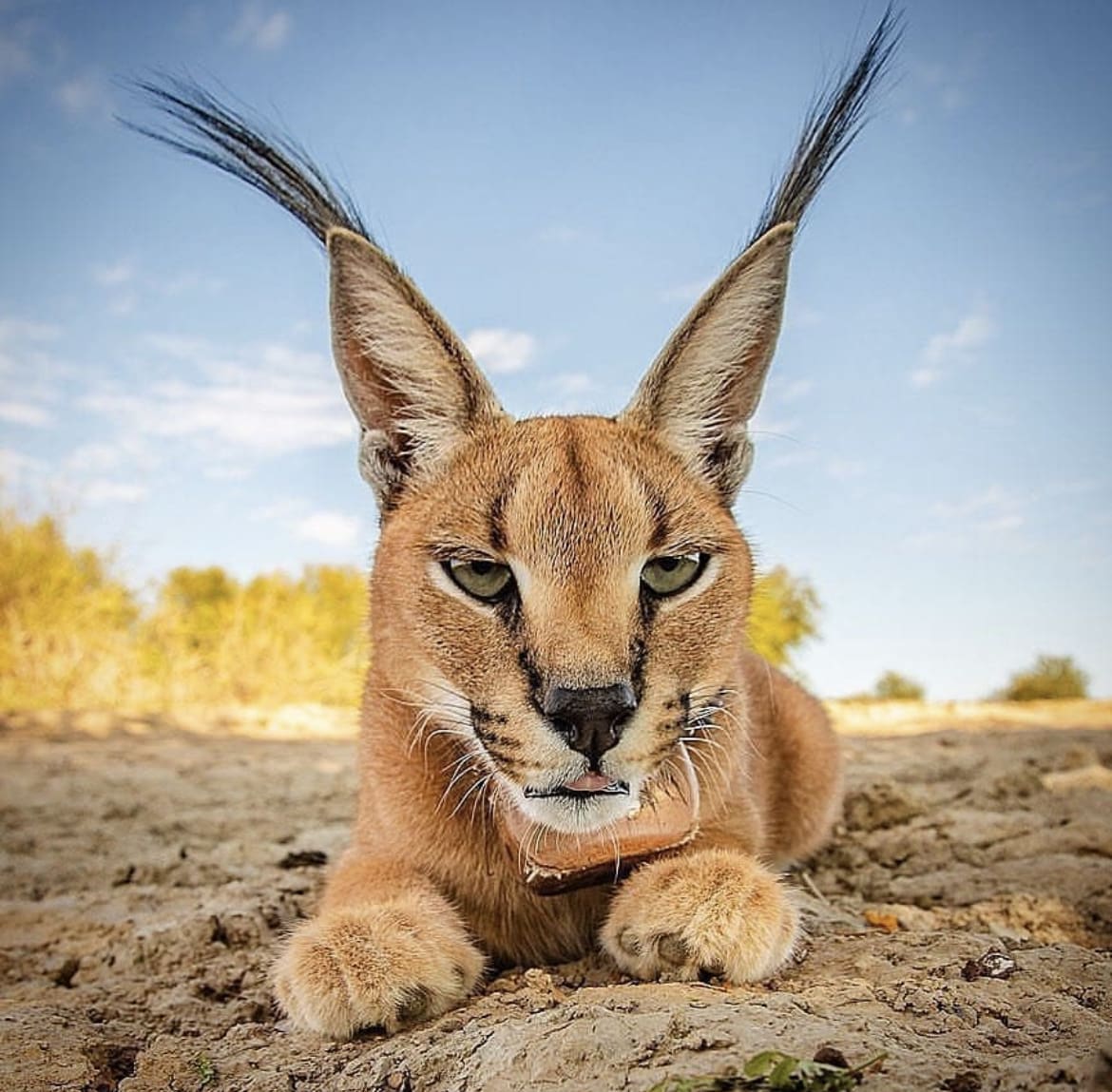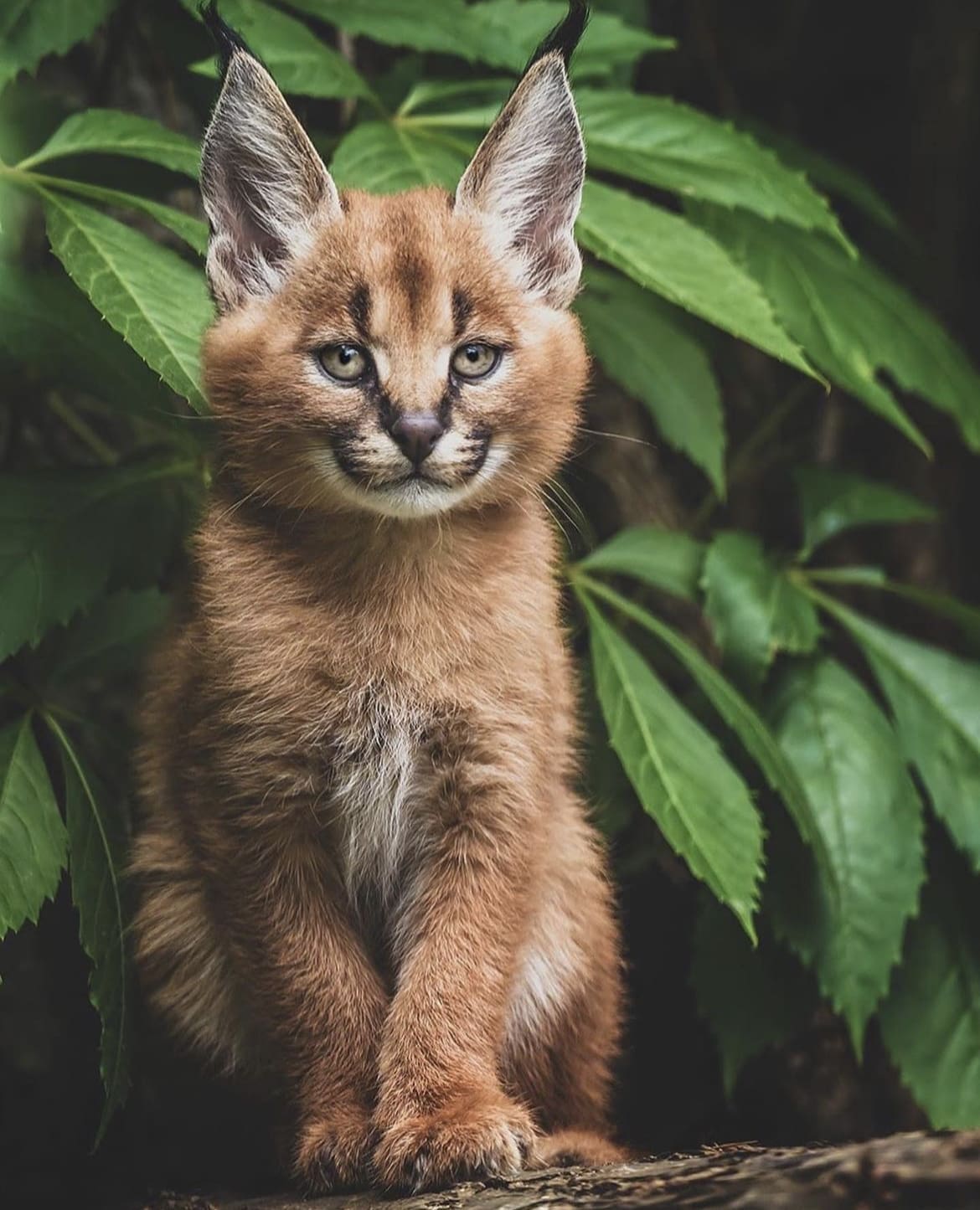Incredibly stealthy and very rarely seen, the Caracal is one of Africa’s most sought after wildlife sightings! These incredible wild cats are always a treat when spotted out on safari.
What is a Caracal?
The Caracal (Caracal caracal), also known as the desert lynx, is a medium-sized wildcat. Known for their skill and remarkable ability to jump up to 3 meters high, caracals are initially found in Africa, the Middle East and Central Asia. It uses these skills to swiftly snatch whatever prey it desires!
Appearance
What does the Caracal look like?
Caracals stand out from other wild cats due to their unique physical characteristics. They have a slim, athletic build, long legs, and short tails. Their fur is typically reddish-brown with black markings on the head, ears, and tail tip.
A caracal’s eyes are golden and have very sharp eyesight. The ears of a caracal are extraordinary – and quite large, which helps the cat locate its prey by using its keen hearing, which allows them to hunt efficiently. It has long claws and powerful hind legs, allowing it to reach up to 50 mph speeds!

How big is the Caracal?
This cat has a distinctive look weighing in at 14 to 40 pounds; caracals are relatively slender compared to other wild cats. The Caracal has a typical lifespan of 10-14 years in the wild and can live up to 20 years in captivity.
Behaviour
How does the Caracal behave in the wild?
Caracals are solitary animals who prefer to stay alone except during mating season. They are active mainly at night and use their sharp eyesight and hearing to catch prey. Caracals are excellent climbers and can leap up to 3 meters (9 feet) in a single bound, making them great hunters. Caracals also use their loud, distinctive calls to communicate with one another over long distances.
What Do the Caracals Eat?
Like other wild cats, Caracals subsist on a diet of small mammals such as rodents, birds, hares and even antelopes. They use their sharp senses of sight and hearing to locate their prey at night. Caracals will also consume insects if needed to supplement their diet. They can also leap high into the air to catch their prey.
Aside from feeding on their prey, caracals occasionally consume vegetation, including fruits and berries.

How Do the Caracal Hunt?
Caracals have impressive hunting skills that set them apart from other wild cats. Their long legs and bodies make them exceptionally fast, allowing them to reach up to 50 mph when chasing prey. Furthermore, they use stealth tactics such as stalking and surprise attacks to catch their meal. Their sharp senses of sight and hearing help them locate prey in the dark, giving them an advantage over other predators. These special hunting skills make caracals one of the most successful cats for catching small animals.
Hunting can be difficult for caracals in some areas, as they may need access to sufficient prey. This is why we need to help conserve their habitats and ensure that these cats have enough food sources to survive in the wild.

Do Caracals live in groups?
Caracals are solitary animals which usually live and hunt alone. They are most active at night but can also be seen in areas with little human activity during the day. While caracals do not form social groups like lions or other wild cats, they may occasionally meet to mate when it is breeding season.
Caracals’ social life is essential to their survival. They use calls and visual cues such as marking trees with urine or leaving scat to stake out territories. Caracals mark the boundaries of their territory to keep other cats away, preventing competition for resources and potential conflict with rivals.
How Do Caracals Reproduce?
Caracals breed once a year, usually during the spring and summer months. Caracals use loud calls to attract potential mates. These sounds travel long distances, allowing caracals to find their partners from far away. They will then come together and mate during the breeding season. When males and females are ready to breed, they engage in a courtship ritual that includes mutual grooming and scent marking. After the female is pregnant, the male will provide for her and protect their territory until the kittens are born.
After a gestation period of around 70 days, the female will give birth to an average litter size of two to four kittens. The mother will take care of her young during the first few weeks after they are born while they remain in the den. The kittens are born blind and helpless; opening their eyes takes approximately six weeks. They usually become independent at 3-4 months old and start hunting independently. As they age, the kittens explore the environment and practice their hunting skills.

Do caracals fight?
Caracals will fight if threatened or when competing for territory. They are equipped with powerful claws and teeth, which they use in fights to defend themselves or their territory. Male caracals can also be seen fighting each other over mating rights, as the female Caracal typically mates with only one male.
Fighting is usually a last resort for caracals, as they are more likely to flee or hide if they sense danger. Overall, fighting is rare among these cats, and they typically settle disputes using vocalizations or scent marking instead.
Range and Habitat
Where to find Caracals?
Caracals are found throughout Africa, the Middle East, and Central Asia. From open grasslands and savannahs to woodlands, semi-desert zones and scrub vegetation, they are known for living in an expansive array of habitats. They can also be found on mountains up to 3,000 meters (9,800 feet).
Caracals prefer dense vegetation and rocky outcrops, making reasonable hunting grounds and providing shelter. They may also inhabit agricultural land if it is suitable for their needs. Caracals are also found near rivers, lakes, and streams.

Conservation
The Caracal is classified as the Least Concern by the IUCN. It is a relatively common species whose population has remained relatively high in recent years. For the continued existence of this species, safeguarding its natural environment and eliminating human-made threats are imperative. Additionally, more research needs to be done into the ecology of this species to understand their behaviour better and adapt conservation techniques accordingly.
What are the major threats to caracal populations?
The main threats to caracal populations are habitat loss due to deforestation and other forms of land conversion, hunting and trapping for the fur trade, and competition with other predators such as jackals. Additionally, caracals may be affected by the use of pesticides, which can contaminate their food sources or even directly poison them. Climate change is also a significant threat to Caracal, as shifting environments can make it difficult for them to adapt and survive. Lastly, caracals may be subject to disease or parasite transmission from domestic animals, which could further jeopardize their populations.

Can you keep a caracal as a pet?
Caracals cannot be kept as pets due to their size and wild nature. Local laws in some areas also protect them, and keeping them captive for any reason is illegal. In addition, caracals require specialized care that may only be possible for some pet owners to provide. If you are interested in keeping a caracal, it is essential to contact your local wildlife authorities for more information.
Safari
Where is the best place to spot a caracal on safari?
The best safari to spot a caracal is Kenya’s Masai Mara National Reserve. This reserve is home to abundant wildlife and offers visitors a chance to spot the elusive Caracal. Other great places for spotting caracals include Uganda’s Kidepo Valley National Park, Serengeti National Park in Tanzania, and Etosha National Park in Namibia. While caracals can also be found elsewhere, these locations provide the best chances for spotting one of these majestic cats in the wild.
Tips for spotting caracals on safari
When looking for caracals on safari, make sure to look in areas where there is plenty of scrubs and low-lying vegetation. Caracals are primarily active during the day, so it is best to go out early in the morning or late afternoon when they are most likely hunting. Also, watch for tracks and signs, such as piles of feathers or bones left behind by their prey. Finally, respect Caracal’s privacy if you spot one – it is best to observe from a distance!

Tips for Interacting with caracals
Interacting with caracals in the wild is not recommended. These wild animals can be dangerous, so keeping your distance and observing from afar is best. Additionally, never attempt to feed a caracal, as this could cause them to become habituated to human presence and put themselves at risk of being hunted or trapped. Finally, always adhere to local laws and regulations when interacting with wildlife, as this is the best way to ensure their safety.
If You Find an Orphaned Caracal
If you find an orphaned caracal, the best thing to do is contact your local wildlife authorities as soon as possible. They can provide the necessary assistance and care for the animal. Do not attempt to take the Caracal in yourself, as this could put you and the animal at risk.
It is also essential to remember that caracals are protected by law, so it is illegal to keep them captive or attempt to sell or trade them.
Facts about the Caracal
- The Caracal is the desert lynx, black-eared cat or rooikat in its native range.
- Scientific name: Caracal caracal.
- Average weight: Males weigh between 11 and 21 lbs, while females typically weigh between 8 and 18 lbs.
- Length: The average size of a caracal is between 29 and 40 inches
- Status: The Caracal is classified as Least Concern by the IUCN Red List, though their populations are decreasing due to habitat loss and other threats.
- Diet: Caracals primarily hunt small rodents, but they will also feed on birds, reptiles, insects and even larger prey such as young gazelles.
- Habitat: Caracals are found in various habitats, including savanna, grassland and semi-arid areas.
- Range: The Caracal is native to sub-Saharan Africa, the Middle East and parts of Asia.
- Population: The global population of caracals is estimated to be between 10,000 and 30,000 individuals.
- Threats: Caracals face threats from habitat loss due to human activity, hunting for their fur, and predation by other animals.

Myths about the Caracal
There are many myths and misconceptions about caracals. Listed below are a few of them:
- Caracals are dangerous animals – While caracals can be hazardous, they are generally not a threat to humans unless provoked.
- Caracals make good pets – This is false; while these cats may look cuddly and cute, they can be dangerous if not respected. Caracals have been known to attack humans if provoked, so it is essential always to respect their space and never attempt to approach or handle them.
- Caracals have nine lives – This is a myth, as caracals only have one life to live.
- Caracals are solitary animals- While they prefer to hunt alone, caracals often form small family groups of up to four individuals.
- Caracals are often called “desert lynx” or “African lynx” but are unrelated to the Eurasian lynx.
- Caracals do NOT eat dogs or cats – they typically feed on small mammals such as rodents and birds.
Conclusion
The Caracal is a beautiful, mysterious creature that has captivated people for centuries. While they may look cute and cuddly, it is essential to remember that caracals are wild animals and should always be respected from a distance. It is also important to remember the threats facing caracals today, such as habitat loss due to human activity and hunting for their fur. If you ever find yourself in the presence of an orphaned caracal, your best bet is to contact local wildlife experts for assistance. By doing this, we can help ensure the safety of these magnificent animals.
